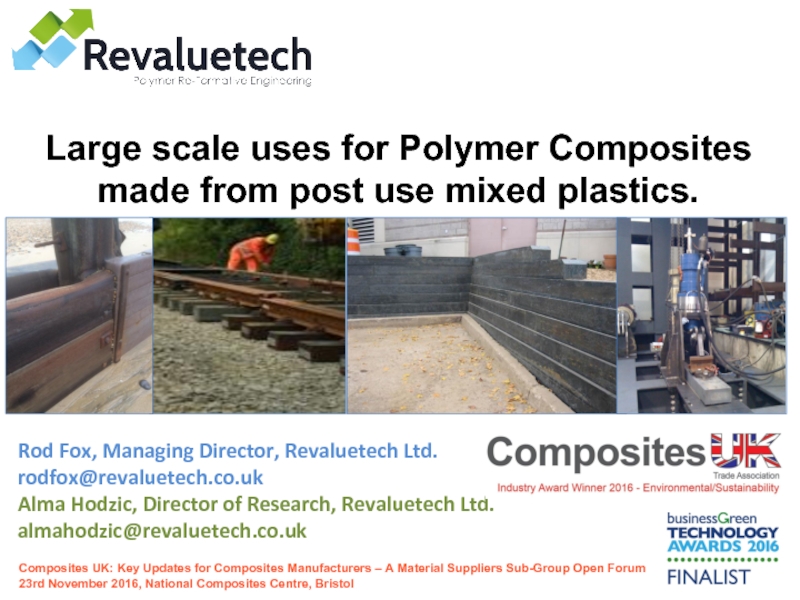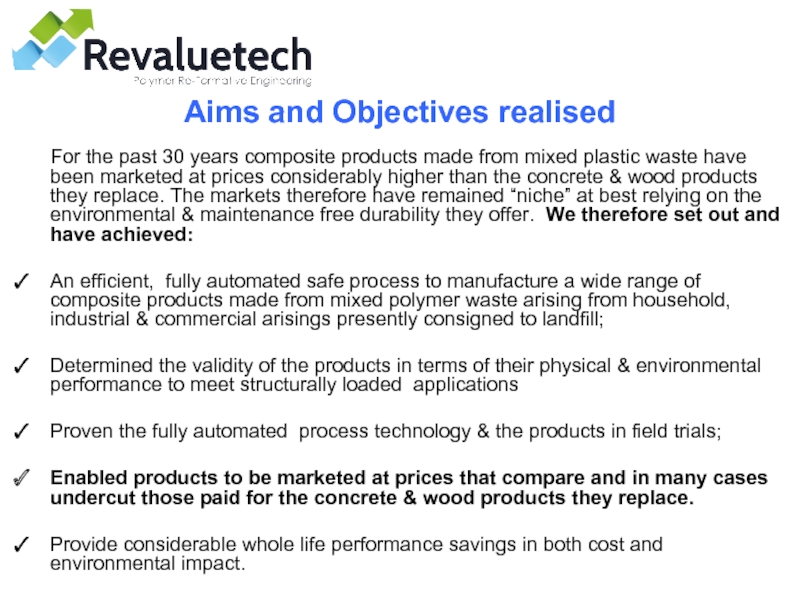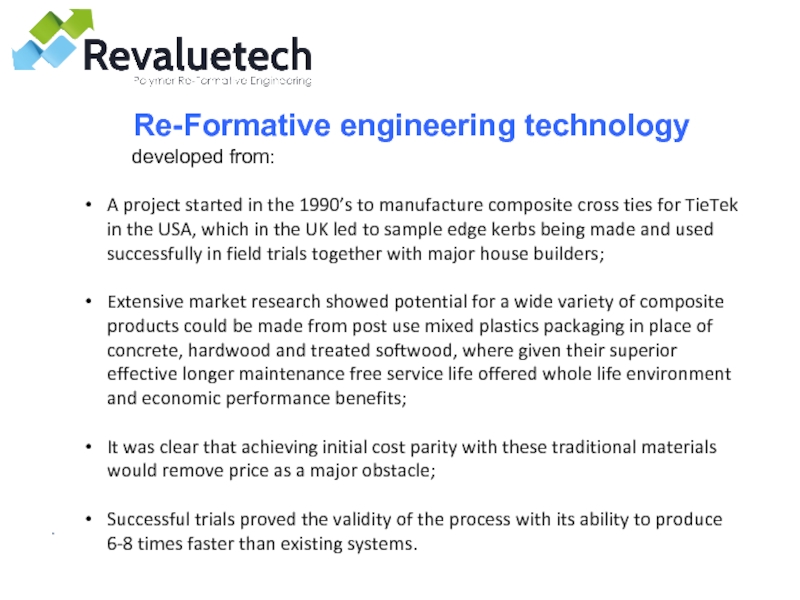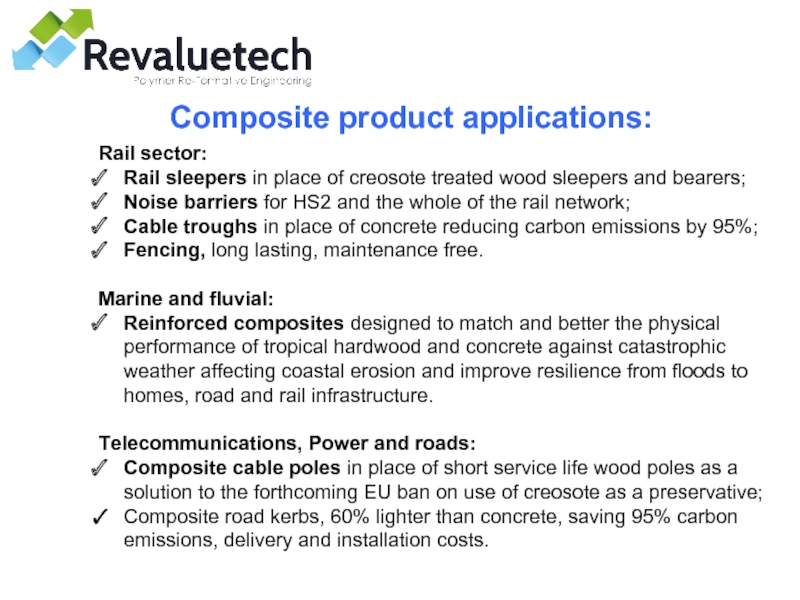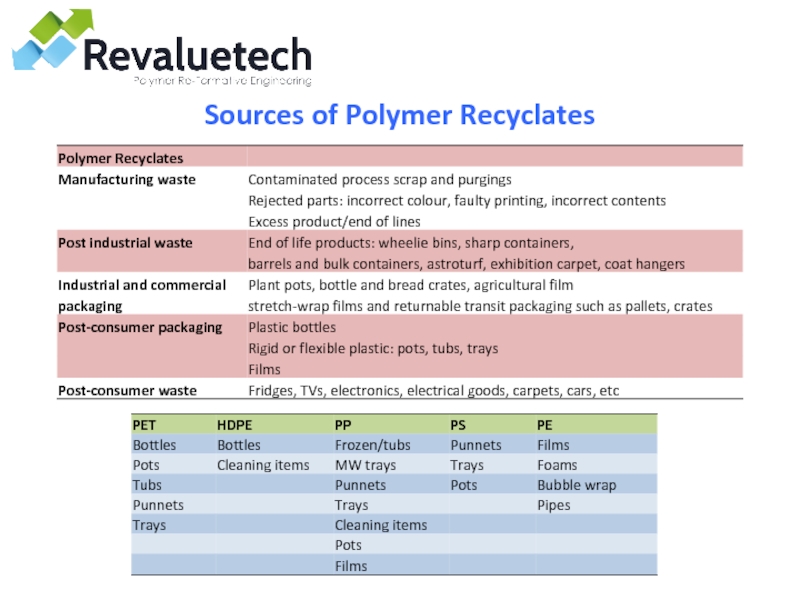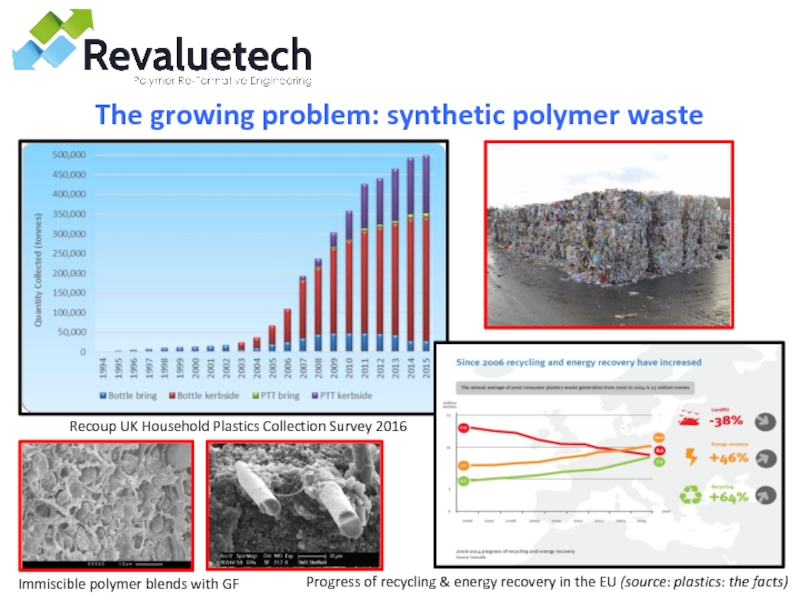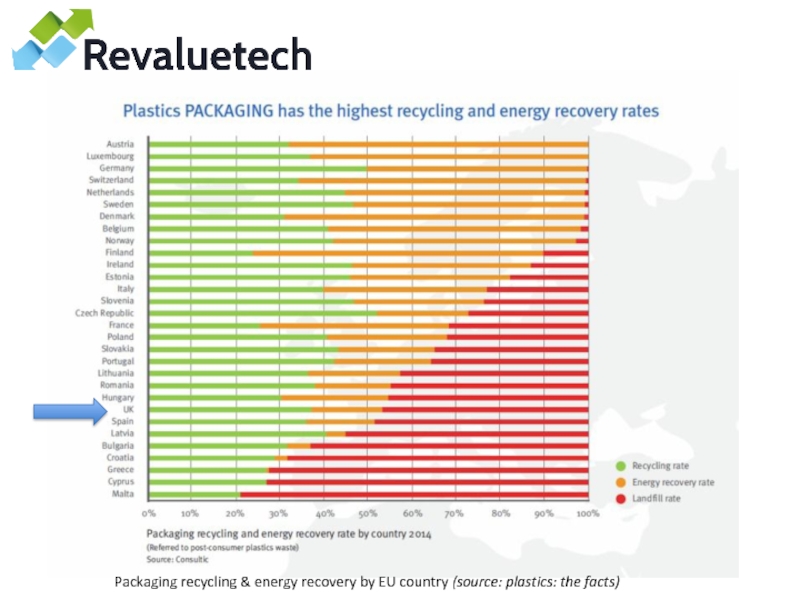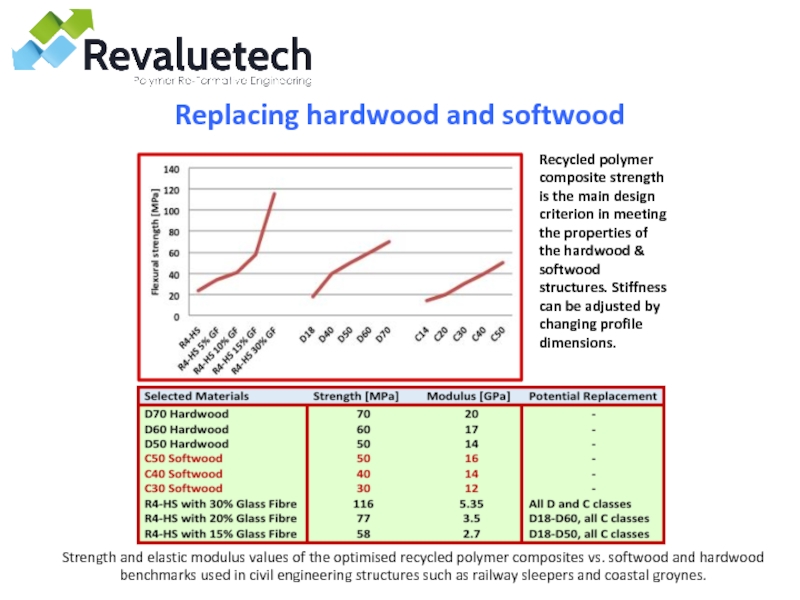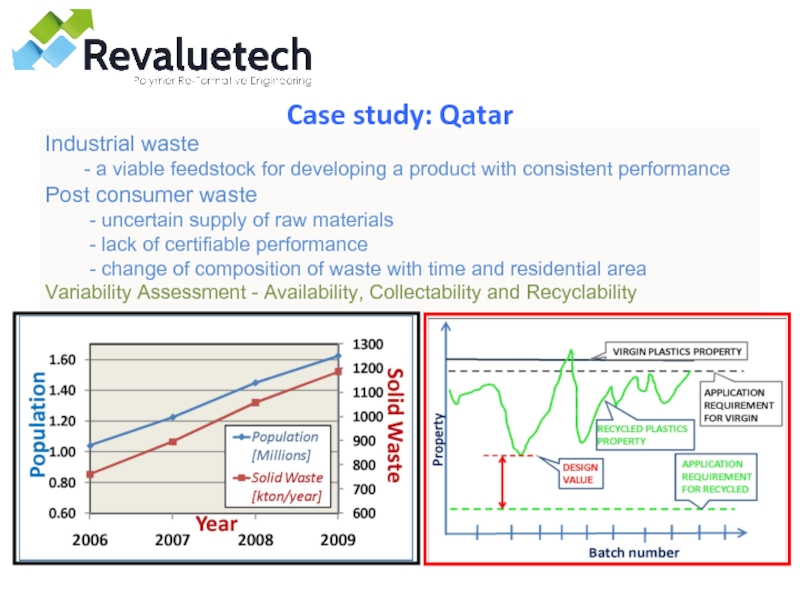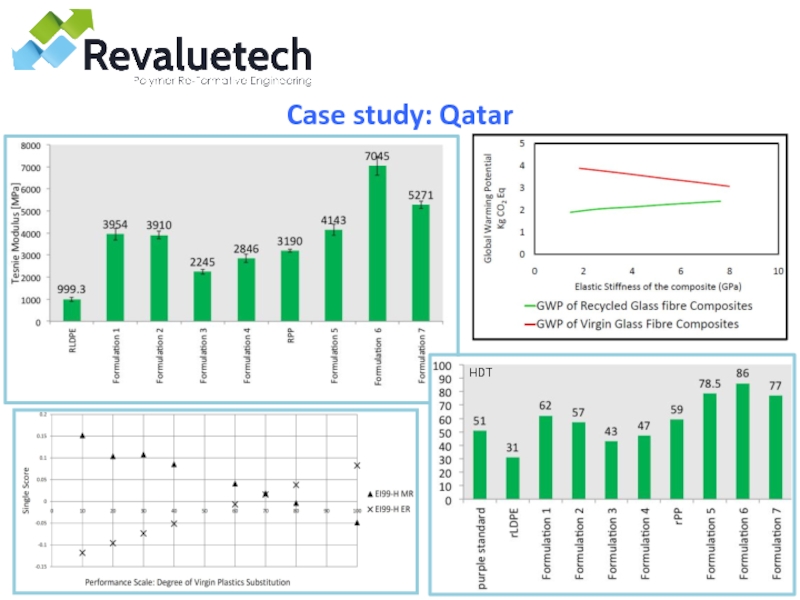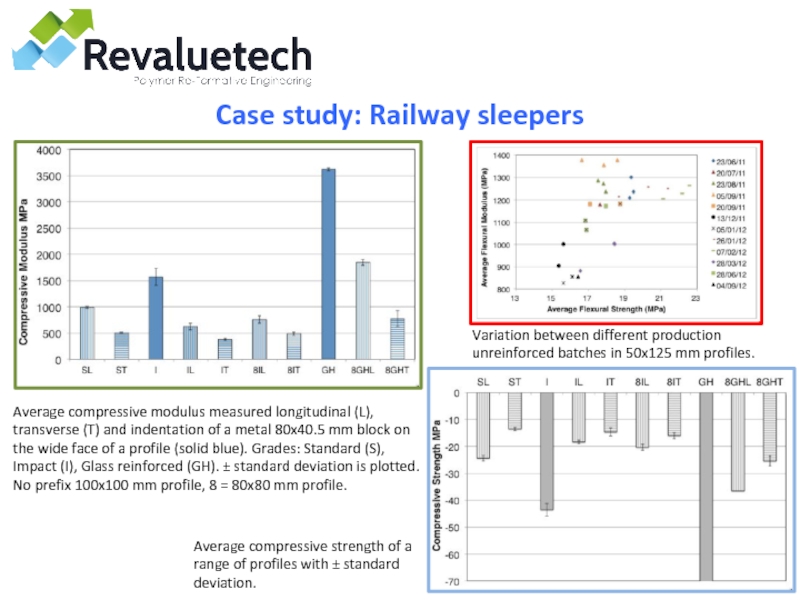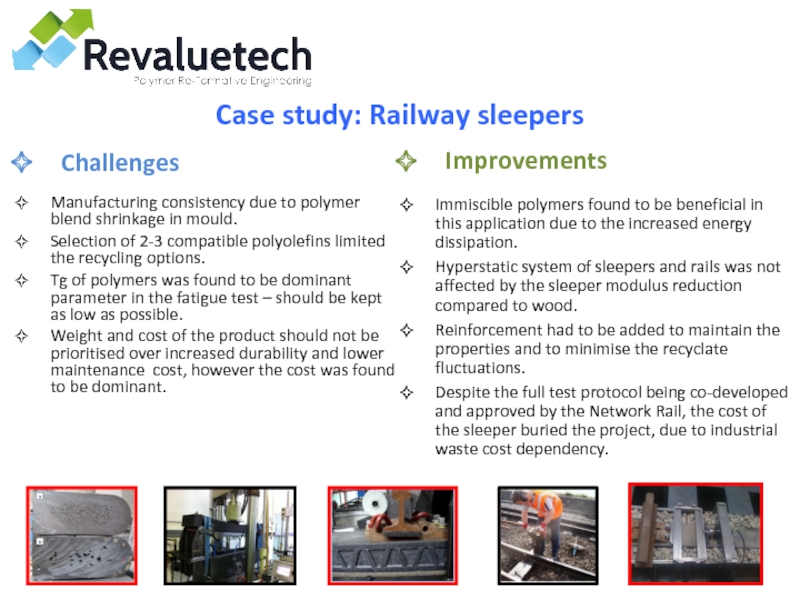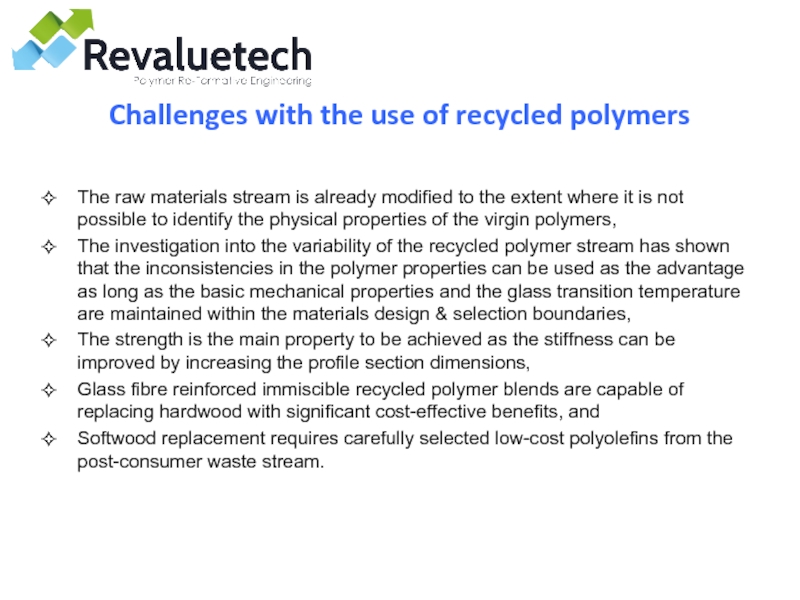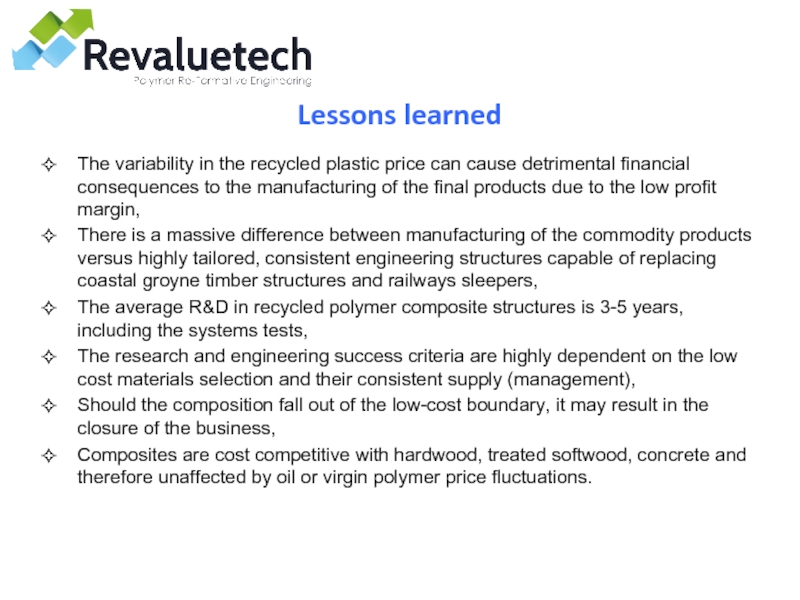Слайд 1Large scale uses for Polymer Composites made from post use mixed
plastics.
Rod Fox, Managing Director, Revaluetech Ltd.
rodfox@revaluetech.co.uk
Alma Hodzic, Director of Research, Revaluetech Ltd.
almahodzic@revaluetech.co.uk
Composites UK: Key Updates for Composites Manufacturers – A Material Suppliers Sub-Group Open Forum
23rd November 2016, National Composites Centre, Bristol
Слайд 2Aims and Objectives realised
For the past 30 years
composite products made from mixed plastic waste have been marketed at prices considerably higher than the concrete & wood products they replace. The markets therefore have remained “niche” at best relying on the environmental & maintenance free durability they offer. We therefore set out and have achieved:
An efficient, fully automated safe process to manufacture a wide range of composite products made from mixed polymer waste arising from household, industrial & commercial arisings presently consigned to landfill;
Determined the validity of the products in terms of their physical & environmental performance to meet structurally loaded applications
Proven the fully automated process technology & the products in field trials;
Enabled products to be marketed at prices that compare and in many cases undercut those paid for the concrete & wood products they replace.
Provide considerable whole life performance savings in both cost and environmental impact.
Слайд 3.
Re-Formative engineering technology
developed from:
A project
started in the 1990’s to manufacture composite cross ties for TieTek in the USA, which in the UK led to sample edge kerbs being made and used successfully in field trials together with major house builders;
Extensive market research showed potential for a wide variety of composite products could be made from post use mixed plastics packaging in place of concrete, hardwood and treated softwood, where given their superior effective longer maintenance free service life offered whole life environment and economic performance benefits;
It was clear that achieving initial cost parity with these traditional materials would remove price as a major obstacle;
Successful trials proved the validity of the process with its ability to produce 6-8 times faster than existing systems.
Слайд 4Composite product applications:
Rail sector:
Rail sleepers in place of creosote treated
wood sleepers and bearers;
Noise barriers for HS2 and the whole of the rail network;
Cable troughs in place of concrete reducing carbon emissions by 95%;
Fencing, long lasting, maintenance free.
Marine and fluvial:
Reinforced composites designed to match and better the physical performance of tropical hardwood and concrete against catastrophic weather affecting coastal erosion and improve resilience from floods to homes, road and rail infrastructure.
Telecommunications, Power and roads:
Composite cable poles in place of short service life wood poles as a solution to the forthcoming EU ban on use of creosote as a preservative;
Composite road kerbs, 60% lighter than concrete, saving 95% carbon emissions, delivery and installation costs.
Слайд 5Realising the potential
Many of the composite product applications do not require
the need for reinforcement. Where products are not subjected to high structural loads, as in the case of kerbing, fencing, cable troughs, experience has shown that consistent quality in terms of toughness and resistance to weathering is achievable using 100% mixed recovered polymers that are presently mostly landfilled. Examples have been in use for more than 40 years in a wide variety of climatic conditions and therefore Revaluetech formed a partnership with Reluma GmbH in Germany to introduce their composites to the UK market.
The need to reinforce the mixed plastics to be used in structurally loaded applications, as in rail sleepers and groyne construction was a missing factor in Revaluetech development. In 2013 collaboration with Univ. of Sheffield was initiated to find ways in which use could be made of their previous composite rail sleeper research programme.
It is from this that earlier this year our “step change” occurred when Professor Alma Hodzic agreed to work directly with ourselves, having left the University where she had successfully led the Composites Engineering function for nine years. Alma will explain how and why the combination of her formulations knowledge combined with Revaluetech processing technology provides the means to avoid destruction of tropical rain forests and reduce carbon emissions associated with concrete manufacture.
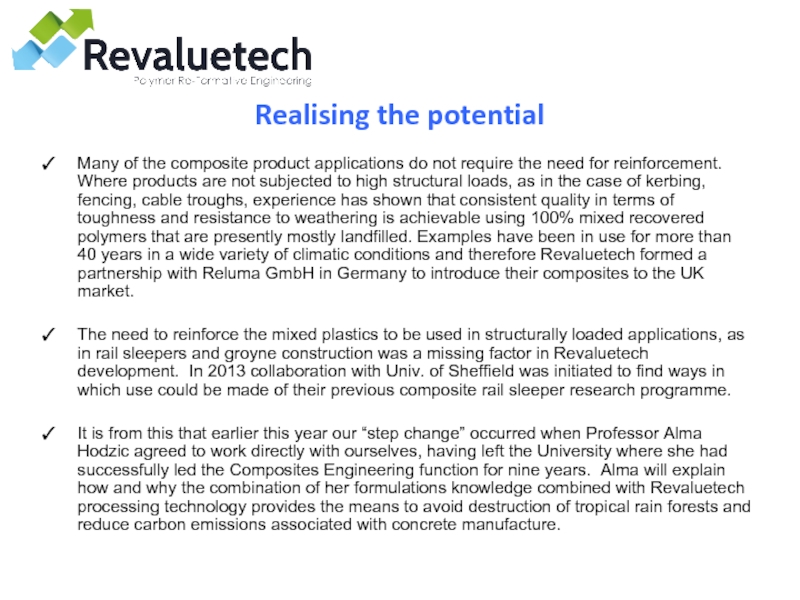
Слайд 6Sources of Polymer Recyclates
Слайд 7The growing problem: synthetic polymer waste
Recoup UK Household Plastics Collection Survey
2016
Progress of recycling & energy recovery in the EU (source: plastics: the facts)
Immiscible polymer blends with GF
Слайд 8Packaging recycling & energy recovery by EU country (source: plastics: the
Слайд 9Strength and elastic modulus values of the optimised recycled polymer composites
vs. softwood and hardwood benchmarks used in civil engineering structures such as railway sleepers and coastal groynes.
Replacing hardwood and softwood
Recycled polymer composite strength is the main design criterion in meeting the properties of the hardwood & softwood structures. Stiffness can be adjusted by changing profile dimensions.
Слайд 10Industrial waste
- a viable feedstock for developing
a product with consistent performance
Post consumer waste
- uncertain supply of raw materials
- lack of certifiable performance
- change of composition of waste with time and residential area
Variability Assessment - Availability, Collectability and Recyclability
Case study: Qatar
Слайд 12Case study: Railway sleepers
Variation between different production unreinforced batches in 50x125
mm profiles.
Average compressive modulus measured longitudinal (L),
transverse (T) and indentation of a metal 80x40.5 mm block on the wide face of a profile (solid blue). Grades: Standard (S), Impact (I), Glass reinforced (GH). ± standard deviation is plotted. No prefix 100x100 mm profile, 8 = 80x80 mm profile.
Average compressive strength of a range of profiles with ± standard deviation.
Слайд 13Case study: Railway sleepers
Challenges
Manufacturing consistency due to polymer blend shrinkage in
mould.
Selection of 2-3 compatible polyolefins limited the recycling options.
Tg of polymers was found to be dominant parameter in the fatigue test – should be kept as low as possible.
Weight and cost of the product should not be prioritised over increased durability and lower maintenance cost, however the cost was found to be dominant.
Improvements
Immiscible polymers found to be beneficial in this application due to the increased energy dissipation.
Hyperstatic system of sleepers and rails was not affected by the sleeper modulus reduction compared to wood.
Reinforcement had to be added to maintain the properties and to minimise the recyclate fluctuations.
Despite the full test protocol being co-developed and approved by the Network Rail, the cost of the sleeper buried the project, due to industrial waste cost dependency.
Слайд 14Challenges with the use of recycled polymers
The raw materials stream is
already modified to the extent where it is not possible to identify the physical properties of the virgin polymers,
The investigation into the variability of the recycled polymer stream has shown that the inconsistencies in the polymer properties can be used as the advantage as long as the basic mechanical properties and the glass transition temperature are maintained within the materials design & selection boundaries,
The strength is the main property to be achieved as the stiffness can be improved by increasing the profile section dimensions,
Glass fibre reinforced immiscible recycled polymer blends are capable of replacing hardwood with significant cost-effective benefits, and
Softwood replacement requires carefully selected low-cost polyolefins from the post-consumer waste stream.
Слайд 15Lessons learned
The variability in the recycled plastic price can cause detrimental
financial consequences to the manufacturing of the final products due to the low profit margin,
There is a massive difference between manufacturing of the commodity products versus highly tailored, consistent engineering structures capable of replacing coastal groyne timber structures and railways sleepers,
The average R&D in recycled polymer composite structures is 3-5 years, including the systems tests,
The research and engineering success criteria are highly dependent on the low cost materials selection and their consistent supply (management),
Should the composition fall out of the low-cost boundary, it may result in the closure of the business,
Composites are cost competitive with hardwood, treated softwood, concrete and therefore unaffected by oil or virgin polymer price fluctuations.
Слайд 16References
Ioannou, A. Hodzic, I. Gitman, C. Soutis, M. Al-Ali, Micromechanical Parameters
in Short Fibre Composite, Applied Composite Materials 01/2014; 21(1).
S Rajendran, L Scelsi, A Hodzic, C Soutis, MA Al-Maadeed, Environmental impact assessment of composites containing recycled plastics, Resources, Conservation and Recycling 60, 131-139, 2012.
M Al-Maaded, NK Madi, R Kahraman, A Hodzic, NG Ozerkan, An Overview of Solid Waste Management and Plastic Recycling in Qatar, Journal of Polymers and the Environment, 1-9, 2012.
Saravanan Rajendran, Lino Scelsi, Alma Hodzic, Constantinos Soutis, Mariam AlMa'adeed, Environmental impact assessment of composites containing recycled plastics, Resource Conservation and Recycling, 60, 131-139, 2012.
A.-M. Hugo, L. Scelsi , A. Hodzic, R. S. Dwyer-Joyce and F.R. Jones, Development of recycled thermoplastic polymer composites for structural applications, Plast. Rubber Compos. 2011; 40(6/7):317-323.
Scelsi L, Hodzic A, Soutis C, Hayes SA, Rajendran S, AlMa'adeed MA, Kahraman R, A review on composite materials based on recycled thermoplastics and glass fibres, Plastics, Rubber and Composites 40(1):1-10 2011.
S. Houshyar, R.A. Shanks, A. Hodzic, Tensile creep behaviour of polypropylene fibre reinforced polypropylene composites, Polymer Testing, Volume 24, Issue 2, 2005, Pages 257-264. (J)
Houshyar S, Shanks RA, Hodzic A. The effect of fiber concentration on mechanical and thermal properties of fiber-reinforced polypropylene composites. Journal of Applied Polymer Science, 2005, 96(6):2260-2272.
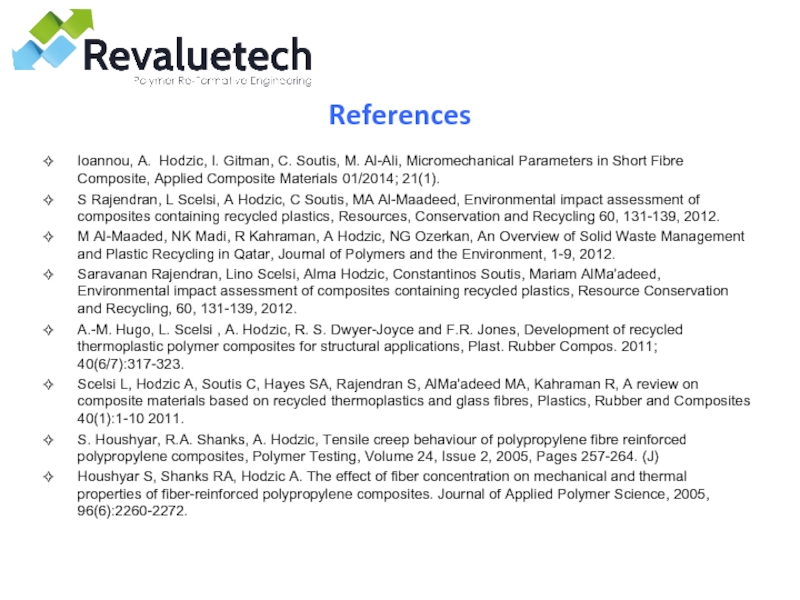
Слайд 18Contact
Rod Fox
Revaluetech Ltd.
PO Box 16170
BIRMINGHAM
B13 3LN
United Kingdom
Tel. +44 (0)121 603
6492
Fax. +44 (0)121 702 2182
Mob. +44 (0)781 426 3364
E-mail: rodfox@revaluetech.co.uk
www.revaluetech.co.uk
